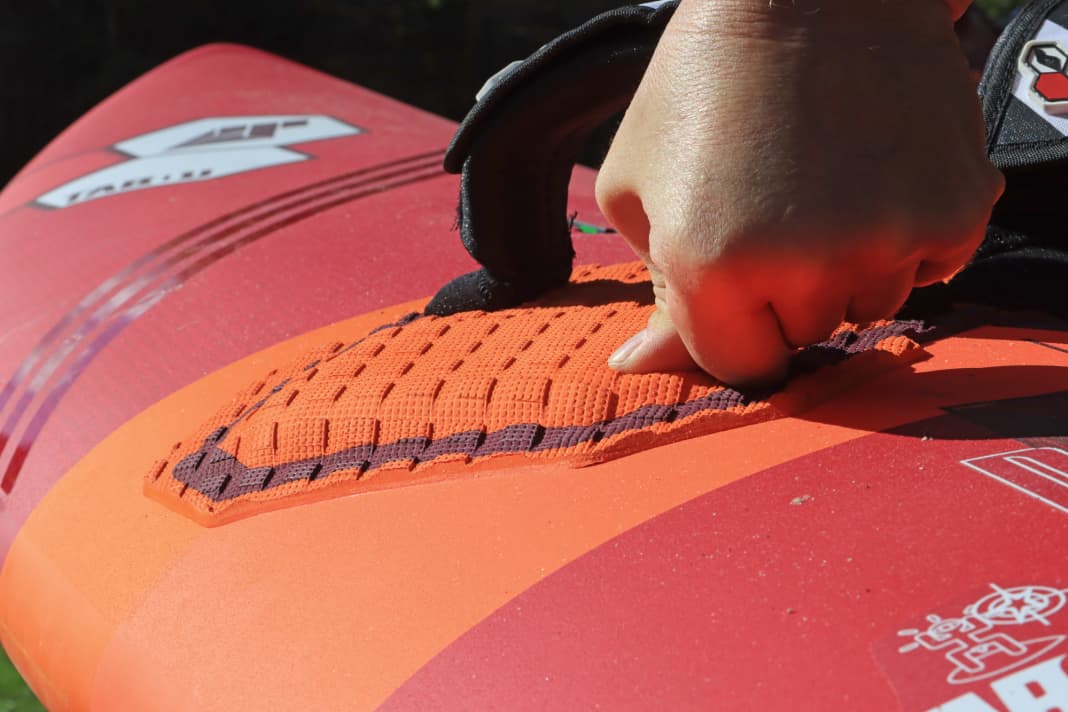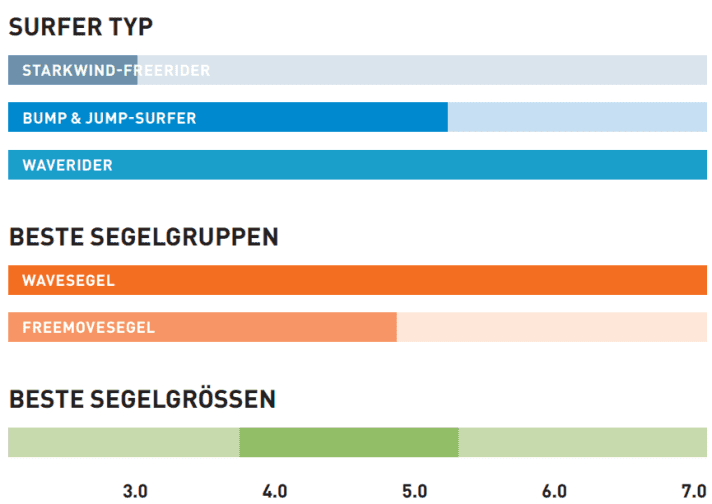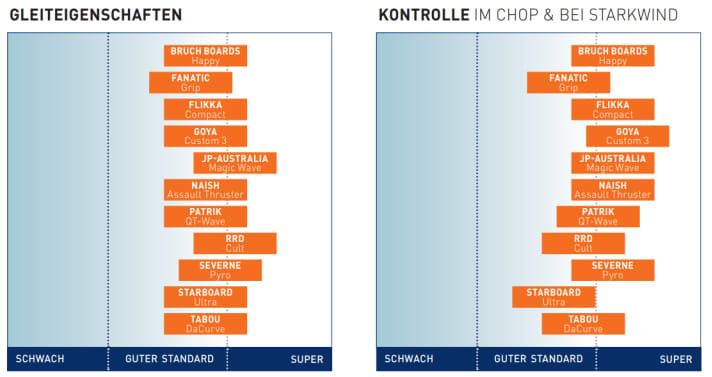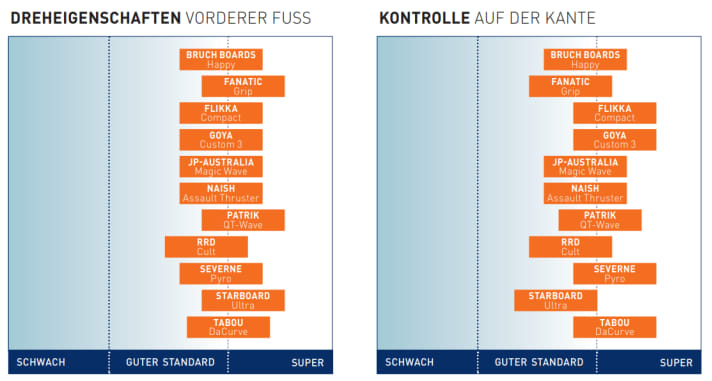





In this article:
"Send us your best all-round waveboard for conditions ranging from bump & jump to mast-high North Sea waves" - that was the request to the manufacturers. And they delivered - eleven boards for the upcoming 2023 season, with concepts that predominantly fulfil the all-round requirement. There are many completely new concepts, but also some unchanged shapes. We would have loved to present the Quatro Power to you, but unfortunately it didn't arrive in time - we'll bring you the results soon.
We carried out our tests on the North Sea and Baltic Sea between the end of August and mid-October and caught many good days with varied conditions. Our conclusion: Rarely has a test group of waveboards contained as many really good concepts as this one. You can read why this doesn't mean that everything is standardised here in the big waveboard test.
These boards were included in the test:
- Bruch Boards Happy 85
- Fanatic Grip TE 87
- Flikka Compact 85
- Goya Custom 3 Pro 86
- JP-Australia Magic Wave Pro 82
- Naish Assault Custom Thruster 89
- Patrik QT-Wave 83
- RRD Cult 88
- Severne Pyro 87
- Starboard Ultra 86 Carbon Reflex
- Tabou DaCurve 88
Price drivers: Why are windsurf boards so expensive?
Almost all everyday items are currently becoming more expensive and leisure items such as windsurfing equipment are unfortunately no exception. The fact that the price increases, compared to the price increases in other areas, are comparatively moderate at ten to 15 per cent, is of little consolation with sales prices of up to 3000 euros for a waveboard. The reasons for this are exorbitant increases in transport costs for container freight, the unfavourable dollar exchange rate and high energy and raw material costs for the production of the boards - cost increases that are felt all the way to the end customer.
You can read more about the price increase for windsurfing equipment in surf 1-2/2023!
Shapes & outlines of the 2023 waveboards
There are again big differences in the outline of the boards, i.e. the ratio of length to width. Boards such as the Tabou DaCurve, Patrik QT-Wave or the Naish Assault Custom Thruster are rather stretched out with lengths of over 225 centimetres, and the tails are also rather narrow. By contrast, the RRD Cult, Severne Pyro, Flikka Compact and especially the Happy model from Bruch Boards are particularly compact. With a measured width of 61.7 centimetres, the latter is over four centimetres wider than the Patrik QT-Wave, for example - with an almost identical volume. So it's no wonder that you should take the rear and overall width into account when choosing the right size. This means that if in doubt, you can choose a Bruch Boards Happy one volume class smaller than a Patrik, Tabou or Naish, for example.
It is also always exciting to look at the rocker lines of the boards, i.e. the bottom curves. Here too, the designers take very different approaches. Shapes such as the JP-Australia Magic Wave or Naish Assault, for example, are almost flat on the centre line, without the bend expected of wave boards. Only in the edge area do the underwater hulls become visibly more curved - this should allow the boards to glide well straight ahead on a flat centre area. The round rocker along the edge only comes into play when the board is edged, which should ensure good turning characteristics.
Equipment and details
Apart from the Patrik QT-Wave, double screws are now standard for the rear straps. Flikka, Naish, Fanatic and JP-Australia even use double screws for the front straps. Starboard only uses single screws at the front, but with much thicker screws. Flikka has a special feature: instead of the usual plastic plugs, the Slovenian manufacturer uses solid double plugs with a steel thread for the Compact model, and the screws are fixed with an Allen key. This is also used for assembly on the Severne Pyro.
With the Cult, RRD offers a great deal of individual leeway for customising the stance, as the plugs are further apart. Naish, on the other hand, has a particularly small crotch width. The distance between the front and rear straps on our test board was more than ten centimetres narrower than the usual measurement. We compensated for this as far as possible during testing by using plugs that didn't belong together, but you can't get to the standard size this way either.
Details of the 2023 waveboards to click through:






Fins: Quad, thruster or all options?
With Fanatic, JP-Australia, Patrik, Severne and RRD, you have all the options for equipping the boards from single fin to quad thanks to the five built-in boxes. A total of seven of the eleven test boards are designed as thrusters, four come out of the box as quads. Unfortunately, the Naish Assault Custom Thruster has no fins at all. The price for a centre fin with 18-19 centimetres and 10 to 11 mm side fins should therefore still be included in the shop price.
The fact that the RRD Cult is equipped with plastic fins is not a disadvantage in terms of performance and durability. Finns made from hard G10 material, such as those supplied with Tabou, Bruch Boards, Patrik and Flikka, are particularly robust and easy to sand again in an emergency.
Riding characteristics: How the 2023 waveboards ride
For the following three most important areas of use, we award up to five "stars" for quick orientation directly in the respective board description.
- Down-the-Line: This term refers to areas with powerful waves and side to side-offshore winds. Typical down-the-line areas are South Africa, Maui, Peru or Chile. Brittany, Galicia or even Denmark can also provide such creamy days, where perfect carving over the rail and maximum turning characteristics at high speeds are required.
- Euro-Wave:This term is representative of areas such as the south of France, the Canary Islands and most German and Dutch wave spots. In addition to turning characteristics, the focus here is on planing, control in chop and suitability for jumping.
- Bump & Jump:Describes the suitability of a board for areas where there are typically no breaking waves, but rather smaller wind or swell waves - such as Lake Garda, many Baltic Sea spots or the Ijsselmeer. The focus is therefore on gliding characteristics, control and smooth running in strong winds.

The path to your personal test winner
As you know, we don't think much of "test winner" labels, simply because there are usually just as many personal test winners for five different surfers. For example, if you rarely get into the surf and expect your 85-litre board to excel in flat water or bump & jump conditions even in strong winds, you can do without maximum radical turns and should rate ride comfort, glide and control higher than someone who tears off 50 wave days a year on their doorstep and flies to the world's top spots in winter.
So ask yourself the following questions: "Where do I mainly surf? What is my current wave level?" To make your decision easier, categorise yourself into one of the following three surfer types and we'll filter out the "losers" for you. From this preselection, you will then find your personal test winner with the help of the individual descriptions and grades.



The surf type recommendation for the right waveboard
Occasional waver" type
Do you use at least 50 per cent of your 85-litre board as a bump & jump board for jumping around and heating up? But you definitely want a real wave board with appealing turning characteristics for your days in the waves? Fast planing, comfort, good top speed and easy cruising in the surf are more important to you than the last bit of radicality? Then the following criteria take priority.
- Sliding properties:Describes how smoothly a board gets up to speed and how powerful the acceleration is.
- Control:If a board runs like on rails in rough choppy waves and has a full, cushioned water position, then it gets the best rating here.
- Maintain speed in the turn:On boards with narrow tails and lots of tail rocker, the wave ride usually ends earlier and less spectacularly than potentially possible. Wider tails and less upturn make it easier to maintain speed through the bottom turn and convert it into a powerful cutback.
With these criteria in mind, you can't go wrong with the following selection (in alphabetical order): Bruch Boards Happy, Flikka Compact, Goya Custom 3, JP-Australia Magic Wave, Naish Assault Custom Thruster, RRD Cult, Severne Pyro
Ambitious wave surfer" type
Do you have no problem riding downwind and do you normally get through the surf without any accidents? Do you sometimes use your waveboard in bump & jump conditions, but mainly surf in European wave areas and want it to work at most wave spots in the world? Then you should still keep an eye on glide and control (see above). But there are two other important characteristics.
- Rotational properties rear foot:This note describes how radically a board can be turned in small waves, i.e. during turns over the back foot.
- Rotational properties front foot:If long radii can be adapted into tight, vertical turns via the front foot, even at high speed, this is ideal for experienced wave surfers. This gives you the chance to always hit the wave at the perfect point. Boards that turn variably over the front foot are also a big plus for wave moves such as 360s.
If you feel addressed here, your hit list is (alphabetically):
Bruch Boards Happy, Fanatic Grip, Flikka Compact, Goya Custom 3, JP-Australia Magic Wave, Naish Assault Custom Thruster, Patrik QT-Wave, RRD Cult, Severne Pyro, Starboard Ultra, Tabou DaCurve.
Wave Crack" type
You ride solid frontside, sometimes jump a loop and you know moves like takas and 360s not only from surf videos? The planing performance will then be sufficient for all boards in this group, and you can subordinate minor compromises in control or speed-holding potential in front of unpressurised waves to maximum turning ability. Then here are your main criteria.
- Rear foot turning characteristics, front foot turning characteristics and control on the edge- a criterion that describes how securely the edge grips even in big waves and bottom turns with a lot of forward lean. If a board runs like it's on rails, it scores full points; if it bounces noticeably, it is penalised.
The hit list for all "wave cracks" is:
Fanatic Grip, Goya Custom 3, Patrik QT-Wave, Severne Pyro, Starboard Ultra, Tabou Da Curve. Equipped with the small fins, the Flikka Compact is also suitable.
All 2023 waveboards in the individual rating
Click here for the detailed test results of all boards:

